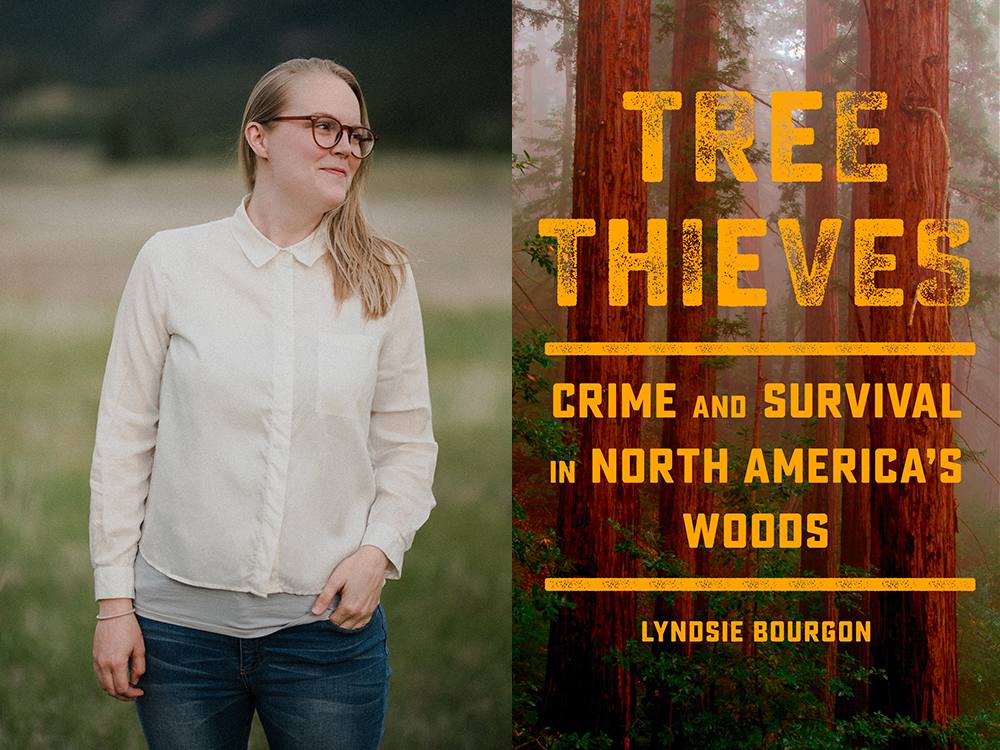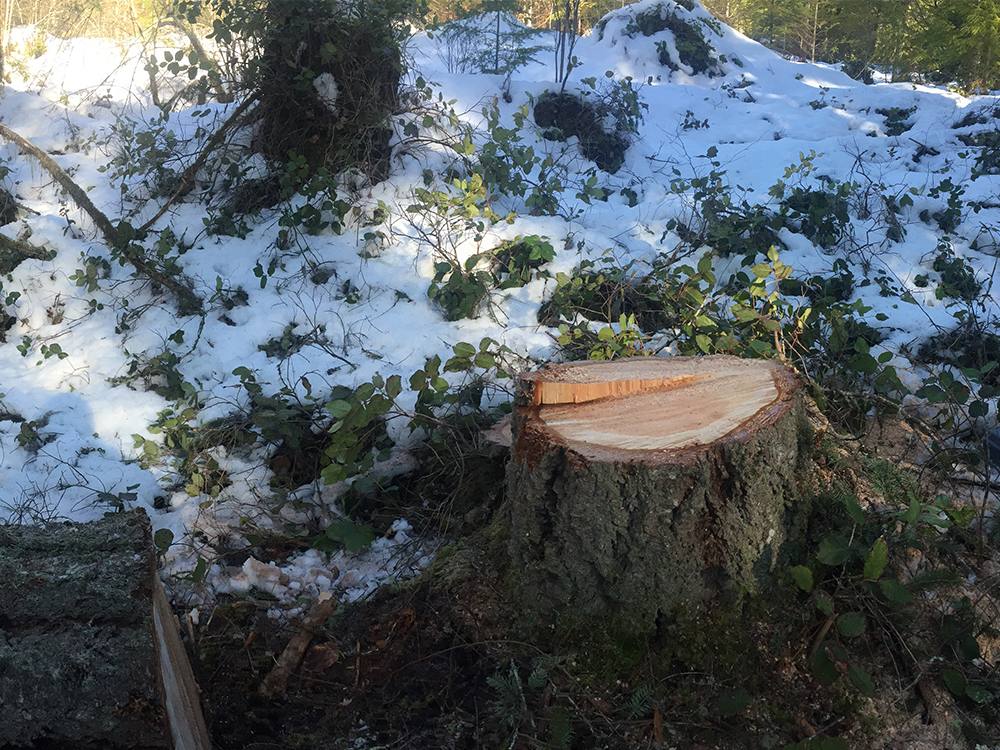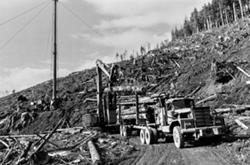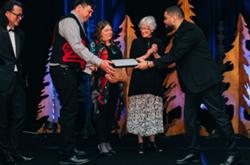[Editor’s note: Many readers in British Columbia will be familiar with the booms and busts of the forestry industry — including old-growth logging. But you may be less familiar with the prevalence of tree poaching and illegal harvesting, which has been happening for decades in the shadow of legitimate industry in the Pacific Northwest. Lyndsie Bourgon’s 'Tree Thieves: Crime and Survival in North America’s Woods' follows poachers and those hot on their tails, delving into why people might turn to illegal harvesting to make their living.]
One sunny spring afternoon in 2019, I shadowed Luke Clarke, a natural resource officer based out of the city of Nanaimo, on his patrol rounds. In the course of just a few hours together, we stumbled across multiple poaching sites along a stretch of road scarcely a mile from the central highway connecting Vancouver Island’s cities and towns.
The shoulders of British Columbia’s forest service roads are dotted with stumps where there should be towering trees. The provincial forests are still rich with coastal Douglas fir, big-leaf maple, hemlock, and groves of old-growth cedar. Over time, residents and environmental activists have persuaded the province to limit logging in many areas near cities and towns. But official restrictions have failed to protect these places from an unprecedented rash of timber poaching. As with redwood trees in northern California, lofty roadside trees made ideal targets because of the very curtain they provide, and in this case an entire tree could be quickly bucked up and loaded into a vehicle.
“I honestly can’t keep up,” Clarke told me. “There’s just so much of it.”
From 2013 to 2018, natural resource officers in British Columbia reported some 2,300 forest crimes. The most common were arson, timber theft and illegal harvesting. The trees targeted for poaching during that time were mainly Douglas fir, cedar and maple, their wood converted into everything from lumber to shake blocks.
Douglas fir was most commonly chopped up and sold for firewood — it burns hotter than other species. Wood could be found for sale on roadsides, or posted online on platforms such as Facebook Marketplace, priced at a flat rate for a truck bed.
Cedar usually ends up as shingles, shake blocks, or furniture. It is roughly three times more valuable than Douglas fir. Cedar’s attributes — its deep, rich colour; its woodsy scent; its habit of stick-straight growth — keep it valued and sought after, especially by builders of saunas and decks.
Maple, notably, requires a certain skill to fell. Unlike a redwood or a Douglas fir, a maple tree branches off, forks, leans and tilts. The historic maple market was primarily sawmills that turned the trees into music wood, but in recent years Clarke had witnessed a new demand surface: “You go to almost any bar in Vancouver, they have that maple, live-edge board table,” he said. “It’s such a common thing. Where is it coming from? Some of it’s legitimate, some of it’s not.”
If you know what to look for, poaching in British Columbia is often easy to spot: muddy tire tracks leading onto a highway from a forest lane strewn with pine needles, with tree branches left scattered along the shoulder.
“It’s like taking one cookie from a jar — no one notices,” said Cpl. Pamela Vinh, one of two investigators with the RCMP Forest Crime Investigation Unit, which is based in B.C. “But a bunch in a row? It’s more noticeable.”

So much poaching was taking place on Vancouver Island by 2019 that natural resource officers, who are charged with preventing revenue loss from provincial forests, were “run off their feet” by the number of trees being felled on their land. The rising rates of forest crime prompted the province to train its natural resource officers in hand-to-hand combat, and a report recommended that they carry batons and pepper spray.
Clarke and I had been driving toward a previously identified poaching site, but new sites were popping up so quickly that he wasn’t surprised when we came across a fresh one. (In the course of a scant hour, we passed three poaching sites in stands of old-growth Douglas fir.)
At the new site, Clarke hopped out of the truck and began to unload the tools he needed to begin an investigation. Using a measuring tape and planting numbered plastic flags, he gauged the size of the tree and photographed its remaining stump and trunk. Using a tablet computer, he then entered this information into a database that would be used to track further investigation of the site. Finally, Clarke scanned the ground for tire tracks or boot prints.
The poached tree had stood in a forest parcel now home to tent communities of unhoused people. In one spot, a deep thicket of woods was intersected by a creek, and the ground around the area was crowded with dead-and-down trees. Through them we spied a makeshift wood bridge that had been placed over the creek, making it easier to cross. The location had been part encampment, part wood-poaching operation — wood had been transported over that bridge and sold as firewood along the roadside or to clients in the nearby city of Nanaimo.
For many poachers on Vancouver Island, market demand is only part of the motivation. In 2018, Nanaimo was home to Canada’s largest tent city (dubbed “DisconTent City” by its estimated 300 residents). The city’s per-capita homelessness rate is among the highest in the province.
The tent city created a crisis of identity in Nanaimo, and citizens flooded radio shows and newspaper comment sections with their opinions. Whereas many locals would prefer to believe that the homeless are outsiders, a November 2018 presentation from the provincial agency BC Housing indicated that the majority of people in the tent city had lived in Nanaimo for years.
Next door to the natural resource officers’ offices is a brand-new housing facility, built to accommodate some of the relocated denizens of DisconTent City. In its parking lot, Clarke occasionally encountered a man he had previously charged with timber theft; it turned out he was living in the facility. “He’s pretty hard up, and is honest and transparent with me when I ask him questions,” Clarke said. “He says you make money just selling firewood.”
Clarke had posted signs high up on electric poles at the entrance to various trails and roads, publicizing an anonymous tip line to report timber theft. He and his fellow officers installed hidden cameras in trees along the highway that cuts through Nanaimo. He spent time seeking out informants from the town around him.
In B.C., this is often where cases stall out in the system. Conservation officers must formulate airtight cases against poachers in order for them to be successfully tried in court. Only half of the province’s 2,350 instances of forest crime tracked between 2013 and 2018 were investigated and prosecuted; of those, a mere 140 made it to the courts.
A further challenge to stemming timber theft is applying the appropriate penalties to those found poaching.
How can we place a numerical value on the deeply holistic worth of an old-growth tree?
Adapted with permission of the publisher from the book 'Tree Thieves: Crime and Survival in North America’s Woods' written by Lyndsie Bourgon and published by Greystone Books in June 2022. All rights reserved. ![]()
Read more: Rights + Justice, Environment
















Tyee Commenting Guidelines
Comments that violate guidelines risk being deleted, and violations may result in a temporary or permanent user ban. Maintain the spirit of good conversation to stay in the discussion.
*Please note The Tyee is not a forum for spreading misinformation about COVID-19, denying its existence or minimizing its risk to public health.
Do:
Do not: